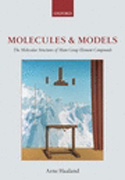
Molecules and models: the molecular structures of main group element compounds
Haaland, Arne
This book provides a systematic description of the molecular structures and bonding in simple compounds of the main group elements with particular emphasison bond distances, bond energies and coordination geometries. The descriptionincludes the structures of hydrogen, halogen and methyl derivatives of the elements in each group, some of these molecules are ionic, some polar covalent. The survey of molecules whose structures conform to well-established trends isfollowed by representative examples of molecules that do not conform. We alsodescribe electron donor-acceptor and hydrogen bonded complexes. Chemists use models to systematize our knowledge, to memorize information and to predict the structures of compounds that have not yet been studied. The book provides a lucid discussion of a number of models such as the Lewis electron-pair bond and the VSEPR models, the spherical and polarizable ion models, and molecular orbital calculations, and it outlines the successes and failures of each. INDICE: 1. Atomic properties: one-electron atoms; 2. Atomic properties: two-electron atoms; 3. Atoms with more than two electrons: atomic properties andperiodic trends; 4. Homonuclear diatomic molecules; 5. Gaseous alkali metal halides: ionic compounds; 6. Other heteronuclear diatomic molecules: polar covalent bonds; 7. Lewis- "cubical atom" model. Molecular orbital calculations on the one-electron molecule H2+ and the two-electron molecule H2; 8. Molecular orbital calculations on heteronuclear diatomic molecules, hybridization, and estimation of net atomic charges from calculated electron densities; 9. Homonuclear diatomic species of the Second Period elements from Li2 to Ne2; 10. Structure and bonding in the gaseous dihalides and dialkyls of the Group 2 and Group12 metals; 11. Structure and bonding in the gaseous monochlorides, trichlorides and trimethyl derivatives of the Group 13 elements; 12. Electron defficientmolecules: three-centre, two-electron bonds; 13. Structure and bonding in simple compounds of the Group 14 elements; 14. Structure and bonding in some simple hydrocarbons and in ethane and ethene analogous of the heavier Group 14 elements; 15. Structure and bonding in simple compounds of the Group 15 elements;16. Electron donor-acceptor complexes; 17. Structure and bonding in simple compounds of the Group 16 elements; 18. Structure and bonding in simple compounds of the Group 17 elements; 19. Structure and bonding in simple compounds of the noble gases; 20. Structure and bonding in oxides and oxoacids of carbon, sulfur, nitrogen, phosphorus and chlorine
- ISBN: 978-0-19-923535-3
- Editorial: Oxford University
- Encuadernacion: Cartoné
- Páginas: 336
- Fecha Publicación: 01/03/2008
- Nº Volúmenes: 1
- Idioma: Inglés
